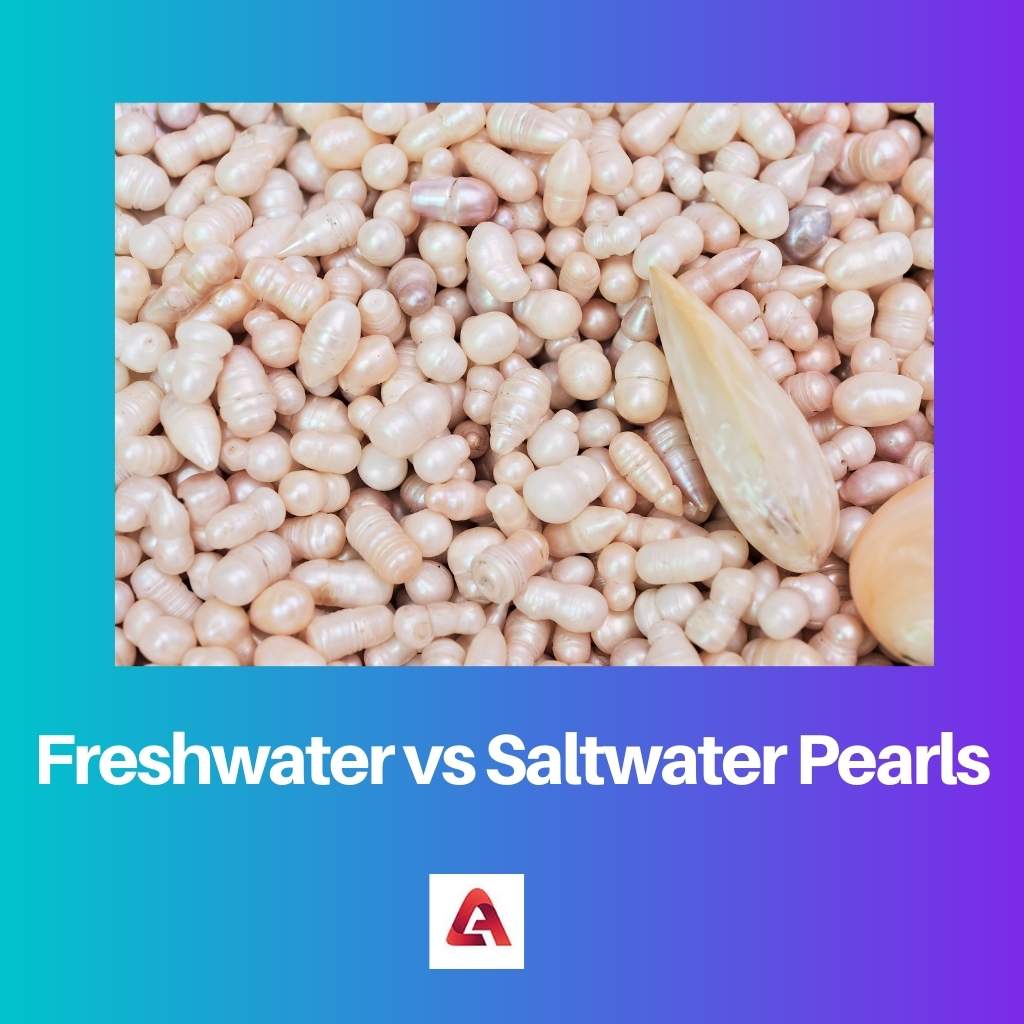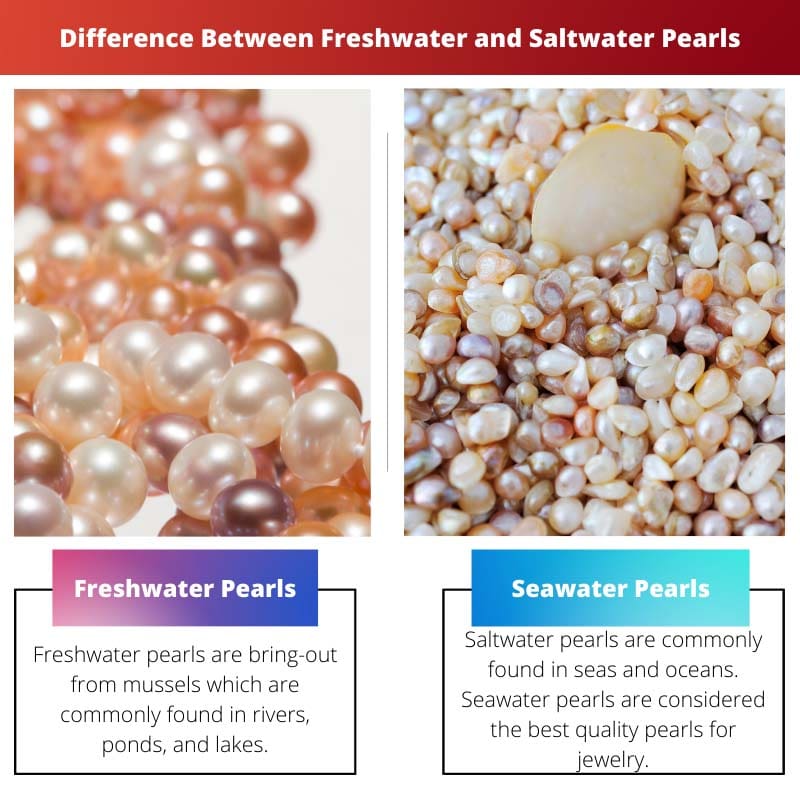We all know pearls are always classy. Freshwater and saltwater pearls are two different types of pearls based on where they originated.
We will discuss in detail the differences between these two freshwater and saltwater pearls based on their appearance, price, and quality.
We are going to compare these two freshwater and saltwater pearls so you won’t be confused between them. So, let’s read in detail about them.
Key Takeaways
- Freshwater pearls are less expensive than saltwater pearls.
- Saltwater pearls are larger and have a higher luster than freshwater pearls.
- Freshwater pearls come in various shapes and colors than saltwater pearls.
Freshwater vs Saltwater Pearls
Freshwater pearls are pearls that have a delicate shape, pastel or white colors, soft lustre, and a thick nacre layer that gives them a shiny look. Saltwater pearls are pearls that grow organically with a high level of lustre, a rounded shape and a glossy appearance. It is found in seas and oceans.

Freshwater pearls are famous for their delicate shape, soft lustre, and white and pastel colors. Freshwater pearls are more durable. If you want to wear your pearls regularly, then freshwater pearls are the best option.
Freshwater pearls have a thick nacre layer, which gives them a shiny look. Freshwater pearl jewellery is more affordable than saltwater pearl jewellery.
Saltwater pearls always have the best quality and luxurious rounded shape. Saltwater pearls quickly grow organically rather than freshwater pearls. Saltwater pearls are more rounded than freshwater pearls.
Saltwater pearls are more expensive because the saltwater oyster produces only one pearl at a time. Saltwater pearls have a higher-level lustre and glossy appearance.
Comparison Table
| Parameters of Comparison | Freshwater Pearls | Saltwater Pearls |
|---|---|---|
| Worth | Freshwater pearls are cheaper | Saltwater pearls are more expensive |
| Appearance | They are not too glossy | They are glossy |
| Nacre | Have a thick layer of nacre | Have a thin nacre |
| Originated | Found in lakes, ponds, and rivers | Found in seas and oceans |
| Shapes | Freshwater pearls have different shapes, colors, and sizes | Saltwater pearls only come in round shapes with cream color |
What are Freshwater Pearls?
Freshwater pearls are brought from mussels, which are commonly found in rivers, ponds, and lakes. These pearls are coated with a thick nacre layer. That’s why they are not so glossy.
Freshwater pearls do not have a specific shape and size like round shapes. They are found in different shapes. Freshwater pearls are smaller and do not have high enough higher quality.
Now by using advanced techniques, freshwater pearls can be taken out with higher quality pearls.
Freshwater pearls are affordable and durable due to their thick nacre.
Freshwater pearls come along with different colors, including pink, blue, peach, lavender, gray, white, and cream, depending on the kind of mollusc in which the pearl is found.
Freshwater pearls are inexpensive. Freshwater pearls have different shapes, colors, and sizes, making them popular choices for jewellery designers.
The most interesting thing we heard about the pearls is that they have a strong connection with the moon. Some properties of freshwater pearls are as follows:
● Color: Freshwater pearls have different types of colors, and the variations of different shades make them unique.
● Luster: Freshwater pearls have the lowest lustre quality, which results in less glossy and shininess.
● Shape: Freshwater pearls have different shapes, including round, oval, and square.

What are Saltwater Pearls?
Saltwater pearls are commonly found in seas and oceans. Seawater pearls are considered the best quality pearls for jewellery. They have a beautiful round shape and lustre.
Saltwater pearls quickly grow organically rather than freshwater pearls. The ranges of saltwater pearls are between four to ten millimetres in size. So, there are several varieties to choose from.
Saltwater pearls have a thin coating of nacre, but they are 100% natural without even dye. Saltwater pearls are more expensive than freshwater pearls due to their high quality and scarcity. Saltwater pearls are highly in demand.
The one reason for the saltwater pearl’s expensiveness is that the freshwater mussel is ampler than saltwater pearls, so their rarity enhances their value. Saltwater pearls are a fabulous kind of jewel.
Saltwater pearls also have durable colors, shapes, and sizes. But they have white and creamy colors. Saltwater pearls have a glossy, natural look. Saltwater pearls are more valuable among buyers due to their high-quality, glossy look.
● Color: Saltwater pearls are found in creamy and white colors.
● Luster: Saltwater pearls have the highest lustre quality, which results in their glossy look.
● Shape: Saltwater pearls are found in round shapes.

Main Differences Between Freshwater and Saltwater Pearls
- Freshwater pearls are found in ponds, lakes, and rivers, while saltwater pearls are found in seas and oceans.
- Freshwater pearls do not have a natural glossy look, whereas saltwater pearls have a natural glossy look due to their lustre.
- Freshwater pearls are less expensive. On the other hand, saltwater pearls are more expensive as they are rarely found.
- Freshwater pearls are not very valuable, while saltwater pearls are more valuable.
- Freshwater pearls do not have higher quality, so they are easily available in the market, while saltwater has higher quality and they are more expensive.

The article provides a clear and comprehensive comparison of the two types of pearls, making it easier for consumers to make informed decisions when purchasing pearl jewelry.
Freshwater pearls come in a variety of shapes and colors, adding diversity and creativity to jewelry designs which may not be as prominent with saltwater pearls.
Saltwater pearls are indeed luxurious and of the highest quality, but freshwater pearls also have their own unique beauty and appeal.
The detailed descriptions of the color, luster, and shape of both types of pearls are very interesting and useful for understanding the differences between them.
I disagree with the comparison table saying that freshwater pearls are not very valuable. While it’s true that they are less expensive, their value should not be understated.
This is a very informative article outlining the differences in characteristics between freshwater and saltwater pearls.
While saltwater pearls are undoubtedly stunning, it’s important to appreciate the uniqueness and affordability of freshwater pearls as well.
The connection between freshwater pearls and the moon is intriguing, I never knew about that before!